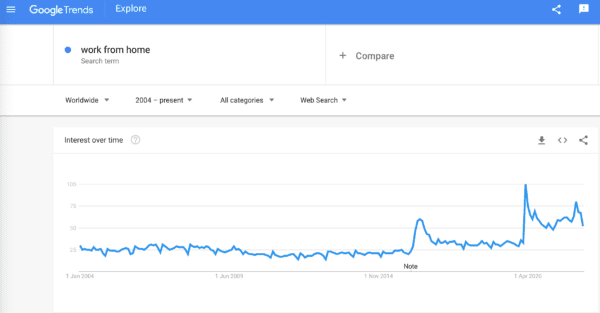Work from home – A credible option.
No longer does ‘I’m working from home’ translate into ‘You’re having a jolly’. As you can see from the google trends graph further down this article – ‘Work from home’ is still gaining popularity. The last peak was in 2016, which coincided with the Zika virus. The Coronavirus is likely to eclipse the searches seen in 2016. And change the way we work.
The relatively new phenomenon of ‘Remote working’ means that we need to learn new ways to work to keep up. To remain productive. To cope. The mnemonic that will help you to become a remote worker is:
M.I.N.D.S.E.T.
We chose this mnemonic because from working in a corporate office to working at home, is largely about how you think and feel. Your mindset. Plus, there are 7 practices, that, if adopted, will help you to survive working at home. And, if implemented effectively, will help you to be someone that is happy, productive, and has a good work-life balance working from home.
(Click on the image below for the extended version)

Learn How to Work Effectively From Home
Becoming a great remote worker is like when you became a great corporate worker. You learnt. This is similar. The only difference is that there aren’t people to watch. You learn by yourself. Learn from what you read and watch. No one is sending you on a training course to learn how to work remotely. Some big companies may provide some resources.
Ultimately, it is down to you to learn how to work at home. This is no small challenge and will require discipline. The alternative is to just start working from home. Then look up 10 years later and wish that you had learnt the best practices from the start.
Please indulge me for a moment with a story…
Learning how to work from home reminds me of a great scene in ‘A Few Good Men’. A courtroom Naval film with Jack Nicholson, Tom Cruise, Demi Moore, Kevin Bacon, and Keither Sutherland. An all-star cast. Tom is a top lawyer grilling an army private on the stand. Cruise is trying to get from the army private that they were taught to give ‘Code Reds’. A term to describe semi-torturing a fellow private when that cadet messed-up in the field. The army publically denies the use of the Code Red practice because a private died during a Code Red. Hence the film and the courtroom drama.
Yet the private on the stand knows about the practice without any formal training. Tom quips, ‘Well, private, how do you know where to eat if no one ever trained you?’. The private replies, ‘I just follow everyone at chow time, Sir’.
In remote working, we have no one to follow at chow time. Yet, we need to learn to change our behaviours. To adapt. This article is your army private at Chow time. It is how you learn remotely. Please share with others to help them. Continue to learn and audit yourself. Check-in on yourself – How are you doing with this remote working thing each month? (An Outlook reminder might not be such a bad idea). Discuss your progress with your line manager.

Summarising our Work From Home M.I.N.D.S.E.T.
Each of the 7 best practices below can be clicked on to take you to a deeper understanding of that best practice.
M is for Manage:
- Establish a Routine – Choose 3 times.
- Do Eat That Frog – Identify your frog each day and eat it first.
- No More Cabbage Butterflies – Remove distractions, e.g. turn off email notifications, and do ‘start to completion’.
- Write a Daily To-Do List – Write a new to-do list each day, and asterisk what must be done that day.
Learn how to manage yourself working from home.
I is for Isolation (Avoid cabin fever):
Get out. Go to a coffee shop. Meet a friend for breakfast. Walk into town. This must become part of your weekly routine to look after your well being. As a minimum every two weeks (Obvious only some apply during the Coronavirus lockdown).
Find out how NOT to isolate yourself working from home.
N is for Neat:
Select your working at home, work clothes. Put these at one end of your wardrobe. Don’t mix them up with the other two ‘wardrobes’.
Know why staying in your pyjamas all day will affect how you feel about work.
D is for Deliverables:
- Have a 121 with your line manager. Or line manager, have a 121 with your reports. Agree on SMART targets for the year.
- Invest time to be the very best version of yourself.
Find out why you are on the payroll and where to start investing in you.
S is for Space:
This is a checklist for your work at home space. Use it to create your proper space at home for you to work. This will help with your mental preparation:
I can:
- Work in this space and relax in a different space.
- Set up a desk for my things.
- Have all the necessary things I need around me; sockets, a place to write, a really comfortable chair, space to move, etc.
- Be confident I will not be disturbed.
- Get the technology to work, i.e. the WIFI and phone signal work.
- Not be seen by delivery people at the door.
- Have natural light.
Getting your own space when you work remotely is very important. Find out how and why.
E is for Emotions:
We have two responsibilities; To ask, ‘How are you feeling?’ and to articulate how we are feeling.
Read about why you need to articulate how you feel.
T is for Technology:
- Test your broadband and mobile phone signal. If they are not up to the job, get them upgraded because your productivity will suffer.
- Use A.C.E to manage your meetings to be effective.
Technology is the foundation of your productivity. See how to ensure that it is up to the job.
M.I.N.D.S.E.T Summarised
The key to not feeling isolated, being the best version of yourself, and achieving the highest productivity is M.I.N.D.S.E.T.
Your mindset is the key.
To unlock the advantages of working at home combined with the challenges it presents, you need to be prepared to learn and then change. Neither of these things is easy to do. But, you learnt how to be a corporate worker from watching others. The same step is to learn from others that have been through the same learning curve. The evolution is to do that remotely by adopting the 7 best practices above.
Thank you to Leanne Massey for helping me to create the mnemonic of mindset.
Working at Home Mistakes and Solutions
Below you can see 18 x 2-5 minute videos sharing mistakes I made when I first started working at home and solutions you can adopt:

As our leading Coach, Nathan Simmonds says, ‘You need to find your operating rhythm’. You will. Best of luck.
Additional WFH Resources
- This document is a bit of a beast – Over 58 pages with many links. It’s not an easy read, but it is jam-packed with great information. Thank you to Thomas Power for sharing.
- Linkedin has created extensive e-learning for working from home. Just a warning. It is over 13 hours, though there are modules. Thank you to Leanne Massey for sharing.
- Feel like you are in a coffee shop with this 1 hour of background coffee shop noises.




